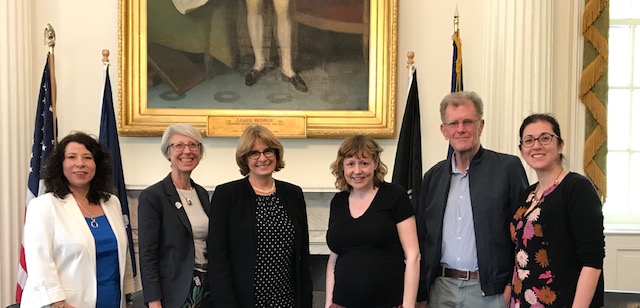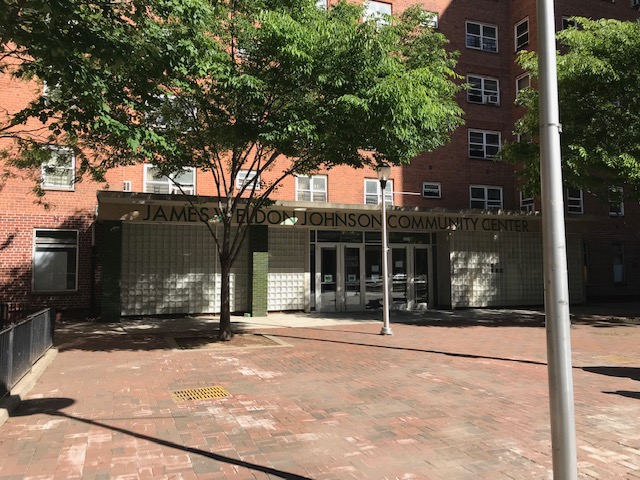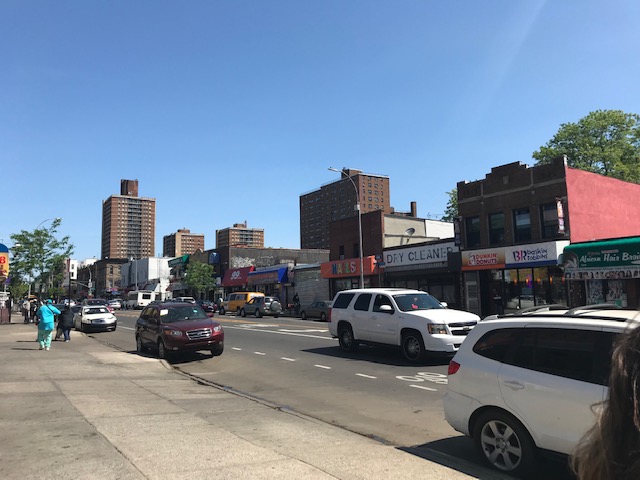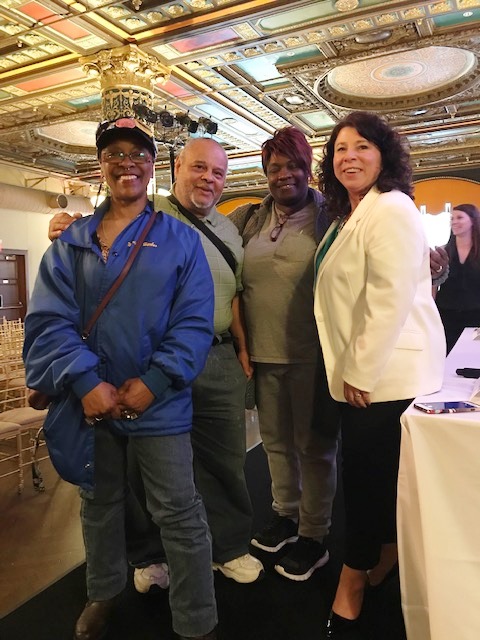Tpas goes international - talking engagement in New York City
Thursday 30th of May 2019

Tpas Chief Executive, Jenny Obsourne blogs about her experience of being invited to speak at a New York housing conference.
Last week Tpas was invited to speak in New York about tenant engagement and social housing in England. Along with Kate Davies, CEO of Notting Hill Genesis and Geoff Bell, tenant from Woodbury Down regeneration area in Hackney, we were guests of the Citizens Housing Planning Council (CHPC) to speak at their conference “Public Housing Revolution” and to meet with senior housing officials and tenants across the city.
So, what is the problem in NYC?
New York City has around 175,000 public housing apartments, housing over 400,000 residents. Public housing is somewhat synonymous with local authority housing in the UK. However, there is only one central housing authority responsible for all of it, despite the buildings being located all over the city.
The housing authority is called NYCHA (New York City Housing Authority). NYCHA is a separate entity to NYC local politics. The housing is controlled and subsidised by the federal government (the department is known as HUD). HUD has been reducing its operating subsidies and capital funding to public housing since the 1980s and there are big gaps between the cost of operation and revenue. Additionally, there are many management and operational inefficiencies seen at NYCHA and it feels like they are completely overwhelmed. Housing conditions have been reaching crisis levels in recent years and the capital repair needs for the 175,000 homes are estimated to be $32 billion (approx. £25b). Homelessness in the city has also sharply risen and becoming increasingly a visible public consciousness issue.
There are some groups representing tenants. Most estates have a Resident Association, and there is a Citywide Council of Presidents (CCOP) as the coordinating body for resident leaders, but they have limited formal power/decision-making abilities. NYC does have a very successful and active affordable housing development industry (both for-profit and non-profit developers) that build over 10,000 new affordable housing apartments a year.
Today, some NYCHA estates are beginning to be transferred to public-private partnerships between NYCHA and affordable housing developers/managers; bringing in new federal, state, city, and private investment to rehabilitate the buildings, and new management. But the transfers are slow and limited. And crucially there is little trust or hope among tenants for any positive change and NYCHA does not really have the capacity for making these transfers happen quickly or easily. And as is the way with America, politics have a huge impact on all this. With a Republican federal government but a Democrat New York Mayor many of the problems are being played out against a backdrop of political tensions and game playing.
The feeling seems to be that all the stakeholders – government, NYC state, NYCHA, tenants and developers have now reached consensus that they have hit crisis point. This is significant in itself as a new starting point. Finding consensus solutions however is the next challenge…
So what was CHPC trying to achieve with our trip?
CHPC are a policy and research unit for the housing sector in New York. They wanted to show that change is possible in a situation like this – and highlight possible ways to structure that change. CHPC looked at England and saw how back in the 1980’s we had a similar stagnancy with council housing conditions, lack of options for tenants, and overwhelmed housing authorities. CHCP and we know that housing is still far from perfect in the England but that substantial change for social housing has clearly occurred since the 1980s by shifting the dynamics of the players involved. CHCP were particularly keen to put a spotlight on the Decent Homes programme, Right to buy, tenant led stock transfers, the growth of housing associations and regeneration good practice.
Most pleasingly for Tpas they were keen to showcase best practices for involving residents in regeneration and housing management and to really focus NYC minds on the benefits of a partnership approach with residents in decision-making. More “done with” and less “done to”….
So who did we meet and what did we learn?
Well it was certainly a packed week!. First up was a meeting with Vicki Been, the NYC Deputy Mayor for Housing and Economic Development and her advisors. Not having been in her role long Vicky was keen to discuss the structures that could aid tenants in decision making and the relationship between public and private developers. Her legal background was evident though in her questioning.
She focused a lot on how binding partnership contracts were and in particular it was clear that non-disclosure agreements were a big issue. She was very clear about the scale of the challenges NYC faces but we were at least able to throw some light on possible ways forward albeit with big health warnings about the differences and issues to overcome.

Next up was a visit to a public housing development in East Harlem -James Weldon Johnson Houses. Here we were hosted by CCOP Chairman, Ethel Velez and residents from the area. What an inspirational woman, what an inspirational community!
We discussed housing developments generally and engagement. It was clear that there are huge issues of trust and transparency from the residents. Decades of broken promises, inaction and lack of funding have left them feeling frustrated, angry and exhausted about getting the changes they need in their homes and wider community.
We went on a tour of the community facilities and the wider estate. The apartment blocks are brick built and solid. Exterior wise they look good and the environment was really clean and well maintained. The inside is a different story. Two of the residents took us into their flats. Rightly proud of their own décor, and the pictures of children taking pride of place, the reality is they are living in very dark, cramped and poor quality homes. Mould, damp and rodent infestation are real problems across many many NYCHA properties. And getting repairs done other than the most urgent was seen as almost impossible

Wednesday started with a trip to Brownsville in Brooklyn to meet City Council Member Alicka Ampry-Samuel, Chair of the Public Housing Committee in Brooklyn. Born and bred in Brownsville Alicka is a tour de force. Passionate about the area, angry at the way it has been ignored and neglected and determined to do something about it. Again the issues were of trust.
Previous experiences of for profit developers in Brownsville have left the residents there with a deep distrust of any kind of scheme or redevelopment offer. Yet the community leaders and the residents know their area needs money for improvements and that building market rent homes could bring much needed investment, jobs and wages into the area. It’s a really complex issue.
Our advice was small steps. Deliver on some smaller scale projects first and build trust and reputation in the community. Walking round Brownsvile it was obvious this was an area with multiple issues of homelessness, cash economy, unemployment, lack of basic facilities (it doesn’t even have a school) and certainly no opportunities for leisure facilities or recreation.
I asked one of the residents “if you could change just one thing in Brownsville, what would it be?”. His answer “bring back community participation funding, give us some green spaces to meet and play. Let us get together and do things for the community ourselves”. Not much to ask is it? It was a meeting with NYCHA officials in the afternoon in their offices in downtown Manhattan. Staff from asset management, community development, housing management and more. Again really keen to listen and learn. Think it was here that we really appreciated the scale of the challenges that NYCHA face.
Some quick facts about NYCHA for you
- NYCHA have 175,000+ public housing units across 325 developments
- If NYCHA were its own city it would rank 50th in the US in overall population
- NYCHA houses more residents than cities such as Cleveland, Tampa and Pittsburgh • The average monthly rent of a NYCHA apartment is $522.
- NYCHA’s public housing provides housing for 1 in 22 New Yorkers
- Rent is controlled and linked to income levels – typically never more than 30% of household income • A large proportion of NYCHA staff are also NYCHA residents.


And finally to Thursday and the conference. Over 150 attendees from across all aspects of housing and community organizing in New York. The issues we raised and the questions we were asked are probably for another blog, another day – so so many things to discuss and debate.
I decided to throw caution to the wind and talked about tenant power… the palpable intake of breath in the room was so interesting to see. The concept of tenants on interview panels for staff or for appointing new maintenance contractors or challenging service performance – these are things that are unheard of in NYC. But there were lots of nods and clapping too for all three of us on the panel. Geoff’s experience on Woodbury Down in particular was a revelation.
How tenants worked hand in hand with a private developer and the council to negotiate and reach compromises on all sides. Geoff drew particular laughs when he talked about how at each phase of the regeneration (2000 homes demolished to build 5000 new ones with full right to return for existing tenants) the developer would draw up a “lessons learnt” document.
The tenants committee opt to call it a “mistakes made” document instead! But the intention was the same. Keep revising and improving to save money, give tenants what they actually want and need and deliver a sustainable and evolving redevelopment. It’s clear our messages of partnership working, trust, accountability and engagement landed. But the issues to overcome in NYC are huge.
Overcrowding, voter apathy, volatile political environment, chronic underinvestment, restrictive labour/union agreements and yes being brutally honest, race and racism, all make this a hard hard issue to crack. But the conversations have tentatively started. That has to be a good thing.